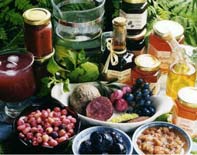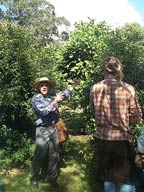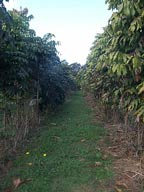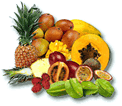October 2002
The Daley News
As so many of us are experiencing a shortage of water it seems like the perfect time to promote some of Australia's most drought resistant plants being our very own bushfood plants. It would be a fallacy to promote bushfoods as being completely  maintenance free and like any plant if they're not watered they'll wither and die, but overall bushfood gardens require less upkeep than ordinary gardens.
maintenance free and like any plant if they're not watered they'll wither and die, but overall bushfood gardens require less upkeep than ordinary gardens.
This month we will be featuring a few of the great bushfoods we have available and Emma has written a great article on her recent bush food adventure. We also have some delicious bushfood recipes and a great offer for all of our newsletter readers.
From now until Christmas we are happy to offer two bushfood plants for the price of one in any of our Bush Food lines. That's right, one bushfood plant for free for every one your purchase.
Greg
Growing bushfoods
 Bushfood gardens are low maintenance gardens that are water-saving and environmentally friendly. Like most native gardens they require little once established but like all plants they respond best to a great start.
Bushfood gardens are low maintenance gardens that are water-saving and environmentally friendly. Like most native gardens they require little once established but like all plants they respond best to a great start.
Here's how to create a glorious bushfood garden.
1. Choose local species of plants - we suggest that you start out with young plants with health roots
2. Ensure that the soil is well drained - dig a hole for each plant filling the hole with water and watching it disappear within 20 minutes otherwise consider raised beds
3. Add lots of organic matter and compost to the soil - All sorts of materials make great compost including grass clippings, leaves and animal manures
4. Use mulch - its great for conserving moisture and keeping weeds at bay. Remember native plants aren't fond of having their roots disturbed so use mulch as a weed deterrent remembering not to place it too close to the base of the plant
5. Fertilise with organic fertilisers like composted manure or slow-release organic granular fertiliser
6. Prune the plants - generally native plants don't require a lot of pruning but by pinching back the new growth every year or two you will prolong the life of the plants
7. Sit back and watch your bushfood garden reward you with delicious taste sensations, delightful flowers, nature's own perfume and masses of colour.
Visit our bushfood page to learn more about the plants we have available or go straight to the shopping trolley to order these plants. https://www.daleysfruit.com.au/bushfoodintro.htm
Aniseed Myrtle
Bunya Nut
Burdekin Plum
Cedar Bay Cherry
Cut leaf Mintbush
Davidson's Plum
Little Gooseberry Tree
Midyim
Peanut Tree
Rose Apple
Getting enthusiastic about bushfood by Emma
 During September, two of our enthusiastic staff here at Daleys attended the Bush Food Tour of nth NSW hosted by Peter Hardwick, technical botanist and leading Bush Food consultant and Ward Gunn, chef and inspirational teacher of the Native Cooking Cuisine Classes run through ACE.
During September, two of our enthusiastic staff here at Daleys attended the Bush Food Tour of nth NSW hosted by Peter Hardwick, technical botanist and leading Bush Food consultant and Ward Gunn, chef and inspirational teacher of the Native Cooking Cuisine Classes run through ACE.
The tour was held in conjunction with the Lismore Herb Festival and attracted people from the Central NSW coast to Southern Queensland. Throughout the day we visited a number of established Bush Food Plantations and stopped for a gourmet lunch that featured many of the foods that we had explored through the day.
Participants included organic farmers employees and trainers within the horticultural industry (including a specialist trainer of indigenous people), keen jam makers and plenty of interested landholders exploring the diverse possibilities for crop options.
While Peter offered much of his botanical wisdom and technical knowledge of the developments of the bush food industry, Ward keep us salivating with hints and descriptions of the tempting recipes and delights that our native species can offer us.
As well as the popular lines like Lemon Myrtle, Finger Lime, Macadamia Nut, Lemon Aspen, Davidson Plum, Native figs, Lilly Pillys, Native Tamarind, Aniseed Myrtle and Lemon Ironbark we saw the Midyim Berries, learnt how to accentuate the subtle flavours of the Small Leaf Tamarind, discovered how to compliment the sun sensitive Davidson Plums with nurse crops and learnt the tricks of planting patterns so as to establish the healthiest and most fruitful bush food orchards.
We finished the day with a walk around Victoria Park where Peter brought our attention to the lessons we can learn from observing our native forests.
 Peter said "Places like Victoria Park are an opportunity for people to observe the relationships in forest ecology and the implications and considerations we might make to enhance these plants in cultivation."
Peter said "Places like Victoria Park are an opportunity for people to observe the relationships in forest ecology and the implications and considerations we might make to enhance these plants in cultivation."
Overall is was evident both in the enthusiasm of the participants and the observations of the growing industry in our area that Bush Foods are offering us more and more possibilities.
Back here in the Nursery the selection of Bush Foods available is ever increasing. Keep an eye on our website for further resource information, cultivation notes and exciting new recipes.
The scrumptious recipes of the day as contributed by Ward Gunn as shared below.
Native Ginger Curry
Ingredients:
1 tsp vegetable oil
4 tsp finely chopped native ginger root
1 native ginger shoot (Cut into 1cm pieces)
1 tsp red or green curry paste
1 tsp palm sugar
2 lemon ironbark leaves
1 tsp finely chopped Dorrigo Pepper
400ml coconut milk
½ cup cubed sweet potato
½ cup cubed bunya nuts
Your choice of vegetables
Method:
Using vegetable oil sauté the native ginger and curry paste.
Add the coconut milk and reduce by 2/3.
Add the palm sugar, Dorrigo pepper and lemon Ironbark in the final stages.
At the start of the coconut cream reduction, add the native ginger shoot, small cubes of sweet potato and bunya nuts. Steam vegetables separately and serve on the cinnamon myrtle rice. Pour native curry sauce over the top and garnish with native ginger leaf and julienne capsicum.
Cinnamon Myrtle Rice
Ingredients:
1 cup Long grain Jasmine Rice
1 ½ cup Water
5 Cinnamon Myrtle fresh leaves finely chopped
Method:
Wash the rice 3 times and drain off the water.
Add rice and bring water to the boil with the lid on. Stir the rice once only and replace lid. Cook slowly, on a low heat for approx 15 minutes or until rice is cooked.
When the rice is cooked stir in the Myrtle and let sit for 2 minutes with lid on before serving.
Warm Pasta Salad with a Red Bunya Nut Pesto
Ingredients:
Vegetables incl: snow peas, cherry tomatoes, Butter beans, Baby corn, Asparagus and Eggplant.
Penne pasta
Blanched Warrigal Greens
Lemon juice
Bunya Nut Pesto
Roasted Red Capsicum
Ingredients for Bunya Nut Pesto:
1 Capsicum roasted and peeled
100 g Bunya Nut blanched
Basil 1 bunch
50 g Parmesan cheese
1 clove Garlic
200 ml Macadamia Nut oil
50 ml olive oil
2 tsp Ground Dorrigo Pepper
Method:
Place Dorrigo Pepper and 100ml Macadamia oil in a saucepan and put on moderate heat for 2 minutes then allow to cool. Puree roasted capsicum, add to the remaining 100ml of oil. Blanch bunya nut for 4 minutes before removing from shell and allow cooling before finely chopping. Finely chop garlic and add to capsicum and oil. Roughly chop basil in a food processor with olive oil. Process for one minute then add parmesan cheese, bunya nuts, capsicum puree and Dorrigo macadamia oil. Be careful not to over process. Add salt to taste.
The pesto will stay fresh in the fridge for 5 days or more.
To serve, place blanched vegetables, pasta and pesto into a bowl and mix. Garnish with shaved parmesan, roasted capsicum strips and fresh basil leaves.
These Recipes are from the Australian Native Cuisine Cooking Class run by ACE in Lismore, Ballina, and Tweed Heads. For more information and enrolments please contact your local ACE office.
For your Bush Food Supplies
Please contact Ward Gunn
Ph 66856814 or Email: attune@nrg.com.au
PO Box 1240 Byron Bay NSW 2481
The Bush Foods listed above and many more are available at Daleys Nursery.
See our website at www.daleysfruit.com.au or call in and see Emma at the Nursery for more information.
Enjoy!!






